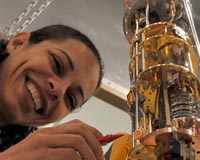 |
Tempe AZ (SPX) Feb 23, 2011 In research appearing in the journal Nature Nanotechnology, Nongjian "NJ" Tao, a researcher at the Biodesign Institute at Arizona State University, has demonstrated a clever way of controlling electrical conductance of a single molecule, by exploiting the molecule's mechanical properties. Such control may eventually play a role in the design of ultra-tiny electrical gadgets, created to perform myriad useful tasks, from biological and chemical sensing to improving telecommunications and computer memory. Tao leads a research team used to dealing with the challenges entailed in creating electrical devices of this size, where quirky effects of the quantum world often dominate device behavior. As Tao explains, one such issue is defining and controlling the electrical conductance of a single molecule, attached to a pair of gold electrodes. "Some molecules have unusual electromechanical properties, which are unlike silicon-based materials. A molecule can also recognize other molecules via specific interactions." These unique properties can offer tremendous functional flexibility to designers of nanoscale devices. In the current research, Tao examines the electromechanical properties of single molecules sandwiched between conducting electrodes. When a voltage is applied, a resulting flow of current can be measured. A particular type of molecule, known as pentaphenylene, was used and its electrical conductance examined. Tao's group was able to vary the conductance by as much as an order of magnitude, simply by changing the orientation of the molecule with respect to the electrode surfaces. Specifically, the molecule's tilt angle was altered, with conductance rising as the distance separating the electrodes decreased, and reaching a maximum when the molecule was poised between the electrodes at 90 degrees. The reason for the dramatic fluctuation in conductance has to do with the so-called pi orbitals of the electrons making up the molecules, and their interaction with electron orbitals in the attached electrodes. As Tao notes, pi orbitals may be thought of as electron clouds, protruding perpendicularly from either side of the plane of the molecule. When the tilt angle of a molecule trapped between two electrodes is altered, these pi orbitals can come in contact and blend with electron orbitals contained in the gold electrode-a process known as lateral coupling. This lateral coupling of orbitals has the effect of increasing conductance. In the case of the pentaphenylene molecule, the lateral coupling effect was pronounced, with conductance levels increasing up to 10 times as the lateral coupling of orbitals came into greater play. In contrast, the tetraphenyl molecule used as a control for the experiments did not exhibit lateral coupling and conductance values remained constant, regardless of the tilt angle applied to the molecule. Tao says that molecules can now be designed to either exploit or minimize lateral coupling effects of orbitals, thereby permitting the fine-tuning of conductance properties, based on an application's specific requirements. A further self-check on the conductance results was carried out using a modulation method. Here, the molecule's position was jiggled in 3 spatial directions and the conductance values observed. Only when these rapid perturbations specifically changed the tilt angle of the molecule relative to the electrode were conductance values altered, indicating that lateral coupling of electron orbitals was indeed responsible for the effect. Tao also suggests that this modulation technique may be broadly applied as a new method for evaluating conductance changes in molecular-scale systems. The research was supported by the Department of Energy-Basic Energy Science program. In addition to directing the Biodesign Institute's Center for Bioelectronics and Biosensors, Tao is a professor in the School of Electrical, Computer, and Energy Engineering, at ASU's Ira A. Fulton Schools of Engineering, and an affiliated professor of chemistry and biochemistry, physics and material engineering.
Share This Article With Planet Earth
Related Links Biodesign at ASU Computer Chip Architecture, Technology and Manufacture Nano Technology News From SpaceMart.com
 Physicists Isolate Bound States In Graphene Superconductor Junctions
Physicists Isolate Bound States In Graphene Superconductor JunctionsChampaign, IL (SPX) Feb 21, 2011 Illinois researchers have documented the first observations of some unusual physics when two prominent electric materials are connected: superconductors and graphene. Led by University of Illinois physics professor Nadya Mason, the group published its findings in the journal Nature Physics. When a current is applied to a normal conductor, such as metal or graphene, it flows through t ... read more |
|
| The content herein, unless otherwise known to be public domain, are Copyright 1995-2010 - SpaceDaily. AFP and UPI Wire Stories are copyright Agence France-Presse and United Press International. ESA Portal Reports are copyright European Space Agency. All NASA sourced material is public domain. Additional copyrights may apply in whole or part to other bona fide parties. Advertising does not imply endorsement,agreement or approval of any opinions, statements or information provided by SpaceDaily on any Web page published or hosted by SpaceDaily. Privacy Statement |